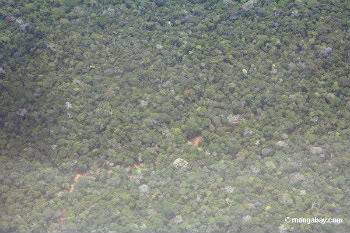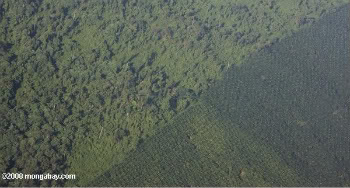|
|
Mongabay.com will be publishing a series of articles on the Smithsonian’s symposium “Will the Rainforests Survive?” over the next few days
New satellite research presented for the first time at a symposium entitled “Will the rainforests survive?” showed that selective logging is impacting over a quarter of the world’s rainforests. Gregory Asner from the Carnegie Institution presented the “first true global estimate of selective logging” which showed that 5.5 million square kilometers of rainforest has already seen selective logging or is slated to be logged in the near future.
Such figures were not possible in the past due to the difficulty of monitoring the impacts of selective logging using satellite imagery. Satellites could detect clear-cutting of the rainforest with great accuracy, but detecting the subtle changes caused by selective logging, which Asner describes as “cryptic”, has only been achieved in recent years with more sophisticated satellite technology.
 Although difficult to see a road runs underneath this canopy, just one example of selective logging.  Clear-cut forest becomes an oil-palm plantations. Oil-palm has become one of the largest drivers of deforestation in the last decade. |
In his talk Asner pointed out that originally tropical forests covered 20 million square kilometers of the Earth. Today half of that has been cleared for human use, mostly for agriculture, timber, and recently, biofuel production . Asner noted that despite decades of attention from the conservation community, deforestation decade-by-decade has risen, not abated. Between 2000 and 2005, 275,000 square kilometers were cleared around the world.
Scientists are still debating the effects of selective logging on the ecosystem. If well-managed, some logging and forest use tactics are regarded by many scientists as being acceptable (as long as they are supplemented with nature reserves), since they provide essential goods for local indigenous populations. However, the bulk of selective logging today does not fall under this category: the vast majority occurs without management or oversight and employs high-impact methods that degrade forests.
Asner warned that in the face of widespread deforestation and degradation, the safety net for the future of the tropical biodiversity was “frayed”.
Previous articles
Selective logging leads to clear-cutting in the Amazon rainforest
(12/31/2006)
A new study links selective logging to clear-cutting in the Amazon rainforest. The research is significant because it identifies “an important indicator of rain forest vulnerability to clear-cutting in Brazil.” A team of scientists, led by Greg Asner of the Carnegie Institution’s Department of Global Ecology at Stanford University, found that 16% of selectively logged rainforests were completely cleared within one year and 32% were totally deforested within four years.
Logging can have low impact on Amazon rainforest says FAO
(11/05/2005)
Selective logging is not necessarily destructive and can be done with low impact on the remaining forests, if the proper techniques are applied, FAO said today, in response to a recent study on logging impacts in the Amazon.
Logging impact worse than thought in the Amazon: “Stealth logging” doubles amount of rain forest disturbance in the Amazon
(11/01/2005)
Research released earlier this month in Science found that Brazil’s Amazon rain forest is being degraded twice as fast as deforestation figures suggest. Selective logging, where only one or two valuable tree species are harvested from an area, is driving the forest degradation. The findings have important implications for “sustainable harvesting” schemes that have been promoted as ecologically-sound alternatives to traditional harvesting techniques.